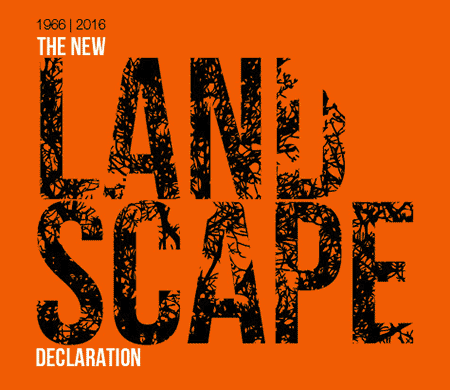An Ambitious Vision for the Next 50 Years: The New Landscape Declaration
After three months of intense deliberation, the Landscape Architecture Foundation (LAF) has released their New Landscape Declaration, a poetic, powerful statement that many will feel captures the aspirations of landscape architects to steer the world onto a more sustainable course. At the ASLA 2016 Annual Meeting in New Orleans, Barbara Deutsch, FASLA, president of the LAF, said the declaration will help landscape architects have a “multiplying effect” beyond their numbers. The declaration, which is written for a global audience, will soon be translated into 30 languages.
“On June 10-11, 2016, over 700 landscape architects with a shared concern for the future were assembled by the Landscape Architecture Foundation (LAF) at the University of Pennsylvania in Philadelphia. Inspired by LAF’s 1966 Declaration of Concern, we crafted a new vision for landscape architecture for the 21st century.
This is our call to action.
Across borders and beyond walls, from city centers to the last wilderness, humanity’s common ground is the landscape itself. Food, water, oxygen – everything that sustains us comes from and returns to the landscape. What we do to our landscapes we ultimately do to ourselves. The profession charged with designing this common ground is landscape architecture.
After centuries of mistakenly believing we could exploit nature without consequence, we have now entered an age of extreme climate change marked by rising seas, resource depletion, desertification and unprecedented rates of species extinction. Set against the global phenomenon of accelerating consumption, urbanization and inequity, these influences disproportionately affect the poor and will impact everyone, everywhere.
Simultaneously, there is profound hope for the future. As we begin to understand the true complexity and holistic nature of the earth system and as we begin to appreciate humanity’s role as integral to its stability and productivity, we can build a new identity for society as a constructive part of nature.
The urgent challenge before us is to redesign our communities in the context of their bioregional landscapes enabling them to adapt to climate change and mitigate its root causes. As designers versed in both environmental and cultural systems, landscape architects are uniquely positioned to bring related professions together into new alliances to address complex social and ecological problems. Landscape architects bring different and often competing interests together so as to give artistic physical form and integrated function to the ideals of equity, sustainability, resiliency and democracy.
As landscape architects we vow to create places that serve the higher purpose of social and ecological justice for all peoples and all species. We vow to create places that nourish our deepest needs for communion with the natural world and with one another. We vow to serve the health and well-being of all communities.
To fulfill these promises, we will work to strengthen and diversify our global capacity as a profession. We will work to cultivate a bold culture of inclusive leadership, advocacy and activism in our ranks. We will work to raise awareness of landscape architecture’s vital contribution. We will work to support research and champion new practices that result in design innovation and policy transformation.
We pledge our services. We seek commitment and action from those who share our concern.”
In the session, Deutsch; Kristina Hill, Affiliate ASLA, University of California at Berkeley; Fritz Steiner, FASLA, dean of the school of design at the University of Pennsylvania; and Laura Solano, FASLA, principal at Michael Van Valkenburgh Associates, all members of the taskforce who contribute to the declaration, offered insights into the process, content, and calls to action. They also noted that the final declaration was written by University of Pennsylvania landscape architecture department chair Richard Weller, ASLA.
“Every word was scrutinized and debated in a very respectful but frustrating process,” said Hill, who was particularly proud the final text came out so strongly on the role of climate change. “Climate change is the driver of so many issues. We needed to be honest about that to address our problems.”
She thinks the document is far less U.S.-centric than the original 1966 declaration. This is because the U.S. is no longer “the most advanced part of the world — that’s Europe. We are now somewhere in the middle.” Furthermore, Japan and China have made huge leaps in infrastructure, while the U.S. is trying to figure out how to move forward with “low-cost, low-maintenance solutions.”
The declaration calls for shifting focus to the most vulnerable. While the U.S. is in no position to “save” developing countries, “we can partner with them,” and share knowledge.
Steiner focused on the declaration’s call to action to “strengthen and diversify our global capacity.” He said there are now about 70 landscape architecture programs in the U.S. and about 300 in China (up from just 1 program in 2000). To further scale up demand for landscape architecture undergraduate and graduate education, “we need to focus on K-12, particularly 1-8.” And to diversify, landscape architects need to target and reach minority students at a younger age. In this effort, “architects and urban planners are natural allies.”
Solano called for landscape architects to do their own part to raise awareness, “educating clients about how green their projects can be” and encouraging them to make more environmentally and socially responsible decisions. “We can lead by raising up what some clients are doing.”
And Deutsch wants all landscape architects to get out there and advocate, going beyond the “sexy” trips to Capitol Hill and engaging in “grit advocacy” by giving public lectures, visiting school groups, and getting involved in their own communities. “Get inside the machine and find out how the system works and then bring your voice to the table.”








Follow Us!